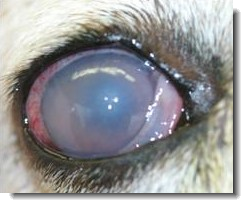
Glaucoma In Dogs:
Types Of Glaucoma In Dogs:
There are two types of glaucoma in dogs. Both cause vision loss and both require much the same treatment. The significant difference is that one type - primary glaucoma - is inherited and its incidence is increasing.
Type 1: (Inherited) Primary Glaucoma
In some dogs, there is a developmental defect of the drainage structures within the eye. This results in inefficient drainage and the eye develops increased pressure - usually in middle age. Primary glaucoma starts in one eye but later always affects both eyes.
Breeds Susceptible To Primary Glaucoma:
The Bassett Hound, American Cocker Spaniel and English Cocker Spaniel are among the increasing number of breeds affected. If you have one of these breeds, you should have a qualified vet perform an examination of the angle inside the eye using a special lens on the eyeball (the examination is called gonioscopy). It will help determine the possible risk of glaucoma developing later. A bad angle inside the eyeball means your dog will start eye dropd for life, to prevent glaucoma in your dog.
Type 2: Secondary Glaucoma (Usually Not Inherited):
If the eye is damaged or diseased, the delicate mechanisms which drain the excess fluid from the globe can be interfered with and partly obstructed. Glaucoma can follow injury and inflammation of the eye (not inherited) or conditions such as lens dislocation.
There are two types of glaucoma in dogs. Both cause vision loss and both require much the same treatment. The significant difference is that one type - primary glaucoma - is inherited and its incidence is increasing.
Type 1: (Inherited) Primary Glaucoma
In some dogs, there is a developmental defect of the drainage structures within the eye. This results in inefficient drainage and the eye develops increased pressure - usually in middle age. Primary glaucoma starts in one eye but later always affects both eyes.
Breeds Susceptible To Primary Glaucoma:
The Bassett Hound, American Cocker Spaniel and English Cocker Spaniel are among the increasing number of breeds affected. If you have one of these breeds, you should have a qualified vet perform an examination of the angle inside the eye using a special lens on the eyeball (the examination is called gonioscopy). It will help determine the possible risk of glaucoma developing later. A bad angle inside the eyeball means your dog will start eye dropd for life, to prevent glaucoma in your dog.
Type 2: Secondary Glaucoma (Usually Not Inherited):
If the eye is damaged or diseased, the delicate mechanisms which drain the excess fluid from the globe can be interfered with and partly obstructed. Glaucoma can follow injury and inflammation of the eye (not inherited) or conditions such as lens dislocation.
How Do You Detect Glaucoma?
If you own a dog of a breed known to be susceptible to glaucoma, be especially on your guard for the following signs:
-The eye suffering from glaucoma is usually red and cloudy.
-The pupil is larger in size than the other eye and does not respond to a light shone onto it.
-A vet can use special instruments to detect the ocular pressure increase of glaucoma.
Treatment Of Glaucoma In Dogs:
Veterinary treatment can be very successful in controlling your dog's glaucoma, but it is usually not curable. Treatments may include topical, oral medications and surgery. Glaucoma detected too late causes blindness and the eye becomes very large. Glaucoma is painful and the vet might recommend removal of the eye.
If you own a dog of a breed known to be susceptible to glaucoma, be especially on your guard for the following signs:
-The eye suffering from glaucoma is usually red and cloudy.
-The pupil is larger in size than the other eye and does not respond to a light shone onto it.
-A vet can use special instruments to detect the ocular pressure increase of glaucoma.
Treatment Of Glaucoma In Dogs:
Veterinary treatment can be very successful in controlling your dog's glaucoma, but it is usually not curable. Treatments may include topical, oral medications and surgery. Glaucoma detected too late causes blindness and the eye becomes very large. Glaucoma is painful and the vet might recommend removal of the eye.

Glaucoma means there is an increase in pressure within the dog's eyeball. The eyeball contains fluid (aqueous). The amount of this fluid, and therefore the pressure it exerts on all parts of the eye, is kept remarkably constant by a fine, sensitive balance between production and drainage of fluid. Reduced drainage means glaucoma. Glaucoma can be very slow and insidious in onset and early cases are difficult to detect. Special instruments (tonometers) are necessary to detect early glaucoma in dogs, so diagnoses can be very difficult even for a vet and specialist veterinary ophthalmologist's examination may be required.
Above: Typical Glaucoma Vision Disorder In Dogs.
Pet Meds: Dogs | Pet Meds: Cats | Dog Health : By Breed | Cat Health : By Breed | Dog Grooming | Cat Grooming | Pet Top 10's | Pet Food Recipes
Pet Meds: Dogs Pet Meds: Cats Common Dog Health Issues Common Cat Health Issues Dog Grooming Cat Grooming Pet Top 10's
Pet Health:Home
Copyright 2006-2011 PetMedsOnline.Org

Online Store For Dogs!
Find everything from basic grooming items and tasty treats, to high tech devices designed for pets!
Find everything from basic grooming items and tasty treats, to high tech devices designed for pets!
Pet Top Lists!
From the friendliest cat breeds to the most intelligent dogs, you'll find it all on our "pet top list" pages!
From the friendliest cat breeds to the most intelligent dogs, you'll find it all on our "pet top list" pages!

